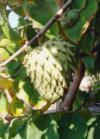April Garden Tips
-
Hold Off Planting Warm-Season Veggies
Wait until the end of the month to sow or transplant vegetables and fruits that prefer very warm weather to mature, including beans, corn, cucumbers, eggplants, melons, peppers, pumpkins, and squash. They will do better when they have consistently warm soil and air temperatures. Planting them when air temperatures are still cool results in growth stress that is difficult for the plants to overcome. Peppers, especially, will just "sulk" if their roots are chilled, and they won't recuperate quickly -- best to just wait until the soil has warmed thoroughly before planting them. Tomatoes are the only exception -- they won't grow much during cool weather, but they'll establish extensive root systems and the top growth will really take off with the first warmth.Include Edible Flowers
Add some edible flowers to your garden for their foliage, blooms, and flavor. You may already grow some -- the edible portions of artichoke, broccoli, and cauliflower plants are all immature flowers. Nasturtium leaves and flowers taste peppery. Squash and borage blossoms have a cucumber-like flavor. Some marigolds taste unpleasantly strong, but others are mild. Be sure, however, to eat only flowers and foliage that haven't been sprayed with a pesticide not registered for food.
Attract Beneficial Insects
To encourage beneficial insects to populate your garden, provide them with their chosen foods and habitats. Umbelliferae family members such as anise, carrot, caraway, coriander, dill, fennel and parsley, with many tiny flowers arranged in tight umbels, and those in the Asteraceae (Compositae) family, such as black-eyed Susan, goldenrod, and strawflower, with a central disc flowers surrounded by many ray petals, attract many beneficials. Mustard flowers attract lacewings that control aphids and parasitic wasps that keep down cabbage caterpillars and coddling moths. Don't worry; these wasps don't bother people or pets.Plant Subtropical Fruit Trees
The weather from now through June is ideal for planting citrus, avocados, and other tender fruits such as kiwis, kumquats, and pomegranates. In frost-free areas, also try cherimoya, guava, mango, and passion fruit. For containers, be sure to choose dwarf type trees. Look for trees with many strong branches, a smooth graft union, and deep green leaves.
Teach Plants To Grow Deeply for Water
Entice plant roots to grow deeply for water to lessen irrigation needs during hot weather. To test how deeply your irrigation water is going, water for the usual length of time and then push a trowel into the soil its full length. Push the soil clump to one side or lift it out completely, and look at both the depth of the roots and the water line in the soil -- it'll be dark toward the surface and lighter down where it's dry. If the water line is not past the longest plant roots, not this far down, water again and then test another spot. Repeat until the water line falls below the root zone. Add all the test irrigation times together to get the total time needed at each watering. Don't water again until two-thirds of the root zone is again dry.With permission from Yvonne Savio, Pasadena, CA


